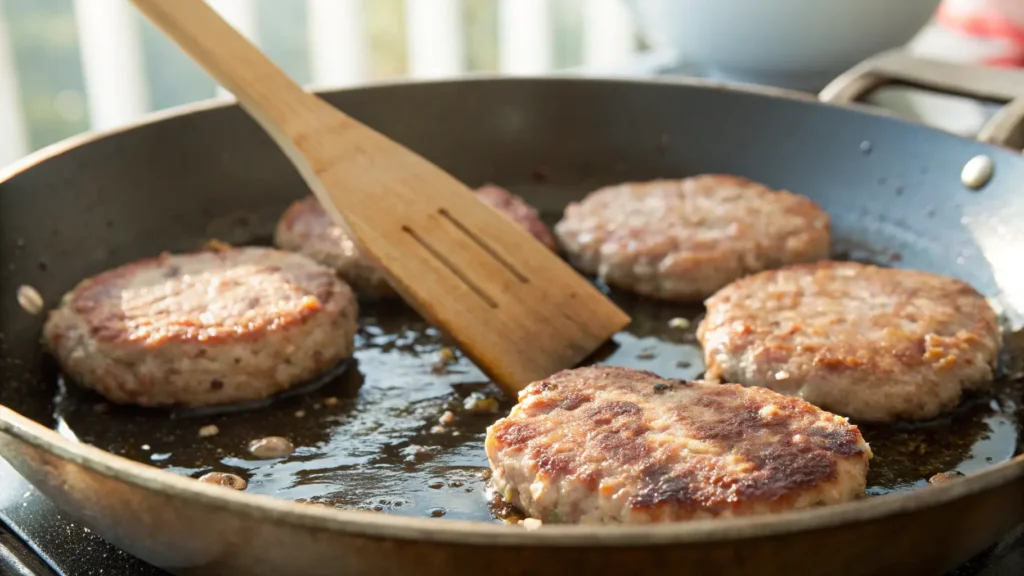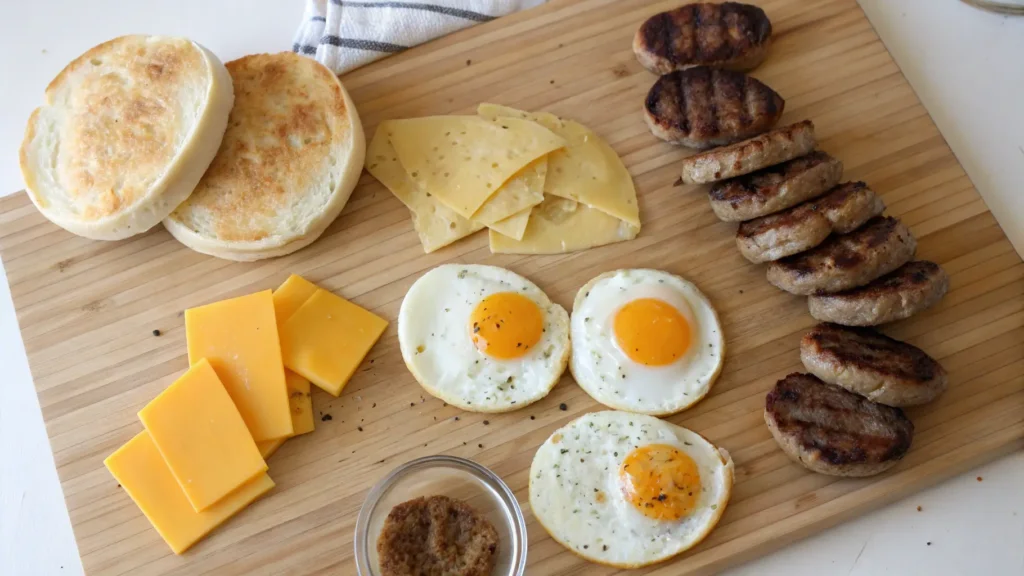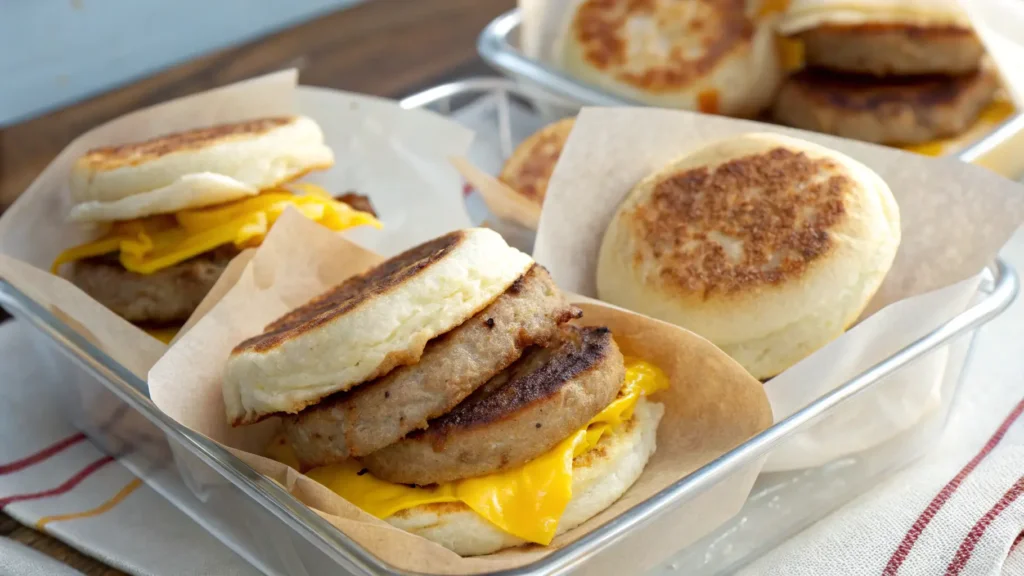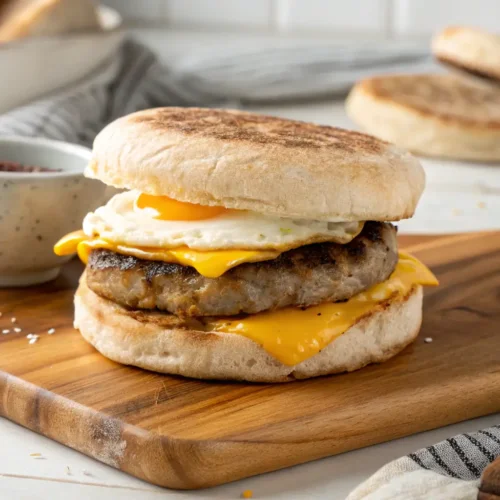Sunday nights in my kitchen always smell like breakfast—even if it’s dinner time. It’s my favorite time to meal prep a batch of these sausage breakfast sandwiches that get me through busy mornings and post-workout hunger pangs without fail.
The first time I made them, I was just trying to find a healthier swap for the overpriced drive-thru version. You know, something quick, filling, and still clean enough to fit my macros. Fast-forward to now, they’re one of my go-to high-protein treats that taste like comfort food but act like fuel.
They’re super easy to whip up in bulk, and every bite feels like a little reward for staying on track. With the right sausage, the right bread, and just a little prep, you’ve got a warm, cheesy, protein-packed sandwich that you can grab from the fridge or freezer, heat, and eat in minutes.
Trust me—these aren’t just for gym-goers. Even my cousin who swears he “doesn’t care about macros” steals two from my stash every time he visits. But hey, good food is good food, and when it works with your goals? That’s a win.
Alright, let’s get into the details. From the ingredients to how I prep them for the whole week, you’re gonna want this in your rotation.
Table of Contents
The Simple Ingredients That Make a Difference
Let’s be real—nailing the perfect sausage breakfast sandwich starts with your ingredients. If you get this part right, the rest is a breeze. It’s not about loading it with fancy stuff. It’s about choosing the right basics that work with your fitness goals and still taste amazing.

Choosing the Right Sausage
This one’s huge. Skip the greasy, mystery-meat kind. I always go for lean beef or chicken sausage with at least 15–20g of protein per patty. Look for ones with clean ingredients—no fillers, no weird extras. If you’re tracking macros, the difference adds up fast.
You can cook them ahead of time and keep them in the fridge for easy use. I pan-fry mine for a nice crispy edge—it’s the texture for me.
Bread That Supports Your Goals
Bread can make or break a sandwich. I switch it up depending on what I’m working on. Cutting? I go for low-carb English muffins or whole grain sandwich thins. Bulking? A hearty whole-wheat bagel gives you the extra calories and fiber you need.
You want something strong enough to hold everything together but still soft when heated. Trust me, soggy bread is the worst way to start your morning.
The Cheese That Melts Just Right
Cheese adds that creamy bite, but not all are created equal. I like using a thin slice of mozzarella or cheddar—enough to melt but not overload on fat. Some shredded part-skim varieties melt better if you’re using a toaster oven.
And if you’re dairy-free? No problem. There are some great plant-based cheeses that still give you that satisfying melt.
Add-ins That Make Every Bite Better
Even a simple sausage breakfast sandwich can be loaded with flavor. I sometimes sneak in baby spinach or grilled onions—easy way to get in some veggies without much fuss. Tomatoes work too, but pat them dry so they don’t mess with the texture.
Season lightly with pepper or garlic powder if you want to bring it up a notch without the salt spike.
If you’re picky about what goes into your sausage, try making it yourself with this easy and clean homemade fennel sausage recipe. It’s flavorful and fits perfectly into any clean meal prep plan.
How to Build a Sausage Breakfast Sandwich Step by Step

Once you’ve got your ingredients ready, putting it all together is super quick. This is where the magic happens, and honestly, it’s way easier than people think. One batch of these sausage breakfast sandwiches and you’ll never go back to fast food versions again.
Cooking the Sausage the Right Way
Pan-fry or air-fry—both work great. I usually go for 3.5 oz beef or chicken sausage patties. Season with a little black pepper if they’re not pre-seasoned.
- Heat a skillet on medium
- Cook patties 4–5 minutes per side until browned and cooked through
- Let them rest on a paper towel to absorb extra grease
Air-frying is great too—just set to 375°F and cook for about 10–12 minutes, flipping halfway.
Making the Eggs Fit Your Style
Scrambled, fried, or folded omelet-style—do what works for you. Personally, I love making them in a muffin tin for meal prep. Here’s how:
- Crack 6–8 eggs in a bowl
- Add a splash of milk (optional), whisk well
- Pour into greased muffin tin slots
- Bake at 350°F for 18–20 minutes
Or just fry an egg per sandwich if you’re cooking on the spot. Keep yolks firm if freezing!
Assembling for Texture and Taste
Layering matters. Here’s the order that works best:
- Bread base
- Cheese slice (it melts better this way)
- Hot sausage patty
- Egg
- Top bun
If you’re meal prepping, let everything cool before wrapping. This helps avoid steam, which leads to sogginess. Wrap each sausage breakfast sandwich in parchment or foil, then store in a zip-top bag.
While your sandwiches bake or rest, I usually multitask with a quick crunchy side like these cottage cheese chips. Light, crispy, and super high in protein.
Nutrition Breakdown
Knowing what’s inside your sausage breakfast sandwich helps you stay on track, especially when you’re counting macros. I’ve tested this recipe over time, balancing flavor and fuel. Whether I’m cutting or maintaining, these sandwiches fit right in.
Below is the nutrition for one sandwich made with the following:
- 1 lean beef sausage patty (about 3.5 oz)
- 1 egg
- 1 slice cheddar cheese
- 1 whole wheat English muffin
| Nutrient | Amount |
|---|---|
| Calories | 365 kcal |
| Protein | 26 g |
| Carbs | 24 g |
| Fat | 18 g |
| Fiber | 3 g |
| Sodium | 610 mg |
If you’re using turkey sausage or skipping cheese, you can bring the fat and sodium down a bit. On the other hand, if you’re bulking, adding another patty or an extra egg bumps the protein over 35g easily. That’s one reason why I keep this sandwich in my meal prep routine—it’s super easy to tweak.
It also beats most fast food options by a long shot. I once compared this to a popular drive-thru version and shaved off 300 extra calories just by making it at home. Plus, I know exactly what’s going in it. No surprise ingredients.
To round out breakfast without messing with macros, I often reach for a sweet bite like these banana bread mini muffins. They freeze well and pair nicely with a warm sandwich.
Meal Prep & Storage Tips for Sausage Breakfast Sandwiches

One of the best things about this sausage breakfast sandwich is how well it fits into a busy lifestyle. You can prep these ahead and have a hot, satisfying breakfast all week. No more skipping meals or grabbing sugar-filled snacks at work.
How to Meal Prep for the Week
Here’s what I usually do on Sundays:
- Cook 5–6 sausage patties
- Make 5 eggs in a muffin tin or skillet
- Toast your bread just a little, so it holds up better after freezing
- Assemble each sandwich and let them cool fully
Once they’re cool, wrap them in parchment paper or foil. I slide all of them into a large freezer-safe bag. Done in under an hour, and I’m set for five days.
Storing and Reheating Without Losing Texture
Reheating is where things can go wrong—nobody wants a soggy sandwich. Here’s how I keep mine tasting fresh:
For fridge storage (up to 4 days):
- Wrap in paper towel and microwave for 60–90 seconds
- Or heat in a toaster oven at 350°F for 8–10 minutes
For freezer (up to 2 months):
- Microwave on defrost for 90 seconds, then heat fully for 60 more
- Or pop in the toaster oven (wrapped in foil) at 375°F for about 15 minutes
Either way, it comes out hot, melty, and ready to eat. I usually grab one while packing my gym bag. It’s honestly better than anything I’ve found at a drive-thru. And I made it myself.
When I batch-prep breakfast, I usually toss in lunch too. One of my go-to combos is this meatball stroganoff. It reheats well and keeps you full until dinner.
Delicious Topping & Pairing Ideas
Even though a sausage breakfast sandwich tastes great on its own, adding a few toppings or sides can make it even better. I like to switch things up so it doesn’t feel like I’m eating the same thing every morning.
Easy Toppings That Add Flavor
Some days, I throw in a little arugula for a peppery bite. It adds a pop of color and takes no time at all. If I’m craving something fresh, I go for thin tomato slices—but only if they’re dry so the sandwich doesn’t get soggy.
You can also try:
- Smashed avocado for healthy fats
- Pickled onions for a tangy kick
- A drizzle of hot sauce for heat
- A few spinach leaves for extra fiber
These little extras help the sandwich feel new, even if it’s the third one I’ve had that week.
What to Pair with Your Sandwich
When I need a full meal that keeps me full until lunch, I pair my sandwich with:
- A protein smoothie (my go-to is banana, almond milk, protein powder, and flaxseed)
- Plain Greek yogurt with berries
- A side of raw veggies and hummus
- A boiled egg if I want to bump up the protein even more
I try to keep the sides simple, clean, and quick. That way, breakfast doesn’t feel like a chore, but I’m still fueling right.
Sometimes I trade the bread altogether for something a little more unexpected, like using this cottage cheese pizza crust as a base. It gives the sandwich a crispy edge and extra protein boost.
Sandwich Variations for Different Fitness Goals
Depending on what I’m working on—cutting, bulking, or just cruising—I tweak my sausage breakfast sandwich to match my goals. That’s the beauty of making them yourself. One simple base, endless variations.
For Cutting or Low-Carb Goals
When I’m in a cut, I usually skip the bread and make a sandwich wrap with large lettuce leaves or low-carb tortillas. I also use turkey sausage or even egg whites instead of a whole egg to save on fat and calories.
- Use egg muffins as “buns” for a zero-carb version
- Try light mozzarella instead of cheddar
- Add veggies to fill you up without the extra macros
These swaps keep the sandwich tasty without wrecking your calorie count.
For Bulking or High-Calorie Needs
On the flip side, when I’m trying to gain, I double up the sausage or use two eggs. I might go for a big whole grain bagel instead of a muffin, and throw in a slice of avocado for some healthy fat.
- Add a second slice of cheese for more calories
- Use a bigger bun or toast
- Serve with peanut butter oatmeal or a protein shake
This way, I’m still eating clean, but I’m getting the fuel I need to train harder and recover faster.
Whatever your goal is, the sausage breakfast sandwich can be tweaked to match. It’s all about finding what works for you—and making it something you actually look forward to eating.
When I’m going full low-carb, these hot honey chicken tenders make an awesome side option. Sweet, spicy, and totally macro-friendly if you’re tracking.
Frequently Asked Questions
What’s the best kind of bread for a healthy sausage breakfast sandwich?
Whole grain English muffins are usually my go-to. They’re light, high in fiber, and hold everything together without getting soggy. You can also try sandwich thins or sprouted grain bread if you’re watching your carbs.
Can I use chicken or turkey sausage instead of beef?
Absolutely. I use turkey sausage a lot when I’m cutting. It’s leaner but still packs a good amount of protein. Just make sure it’s not loaded with added sugar or fillers.
How long do sausage breakfast sandwiches stay fresh in the fridge?
I keep mine in the fridge for up to four days. After that, the texture starts to go downhill. If you want to make a bigger batch, freeze them instead.
Can you freeze sandwiches with eggs in them?
Yes, and they freeze really well if you let them cool fully first. Wrap them in foil or parchment and then put them in a zip-top freezer bag. Reheat them in the microwave or toaster oven when you’re ready to eat.

Sausage Breakfast Sandwich
Ingredients
- 5 whole wheat English muffins split and lightly toasted
- 5 large eggs
- 5 lean beef or chicken sausage patties about 3.5 oz each
- 5 slices cheddar cheese or part-skim mozzarella
- olive oil spray for cooking
- black pepper to taste
- baby spinach, tomato slices, avocado optional toppings
Instructions
- Heat a skillet over medium heat and lightly spray with olive oil. Cook sausage patties for 4–5 minutes per side until browned and cooked through. Set aside.
- In the same skillet or a separate pan, crack eggs and cook until yolks are firm or to your preference. You can also scramble if you prefer.
- Toast the English muffins lightly to add texture and help them hold up better for storage.
- To assemble, layer the bottom half of each muffin with a slice of cheese, followed by the hot sausage patty, then the egg.
- Top with optional spinach or tomato, then place the top muffin half on each.
- Let sandwiches cool slightly if meal prepping, then wrap individually in parchment or foil. Store in the fridge for up to 4 days or freeze for up to 2 months.
- To reheat, microwave for 60–90 seconds (if refrigerated) or 90 seconds on defrost + 60 seconds regular (if frozen). Alternatively, reheat in a toaster oven at 350°F for 8–10 minutes.






